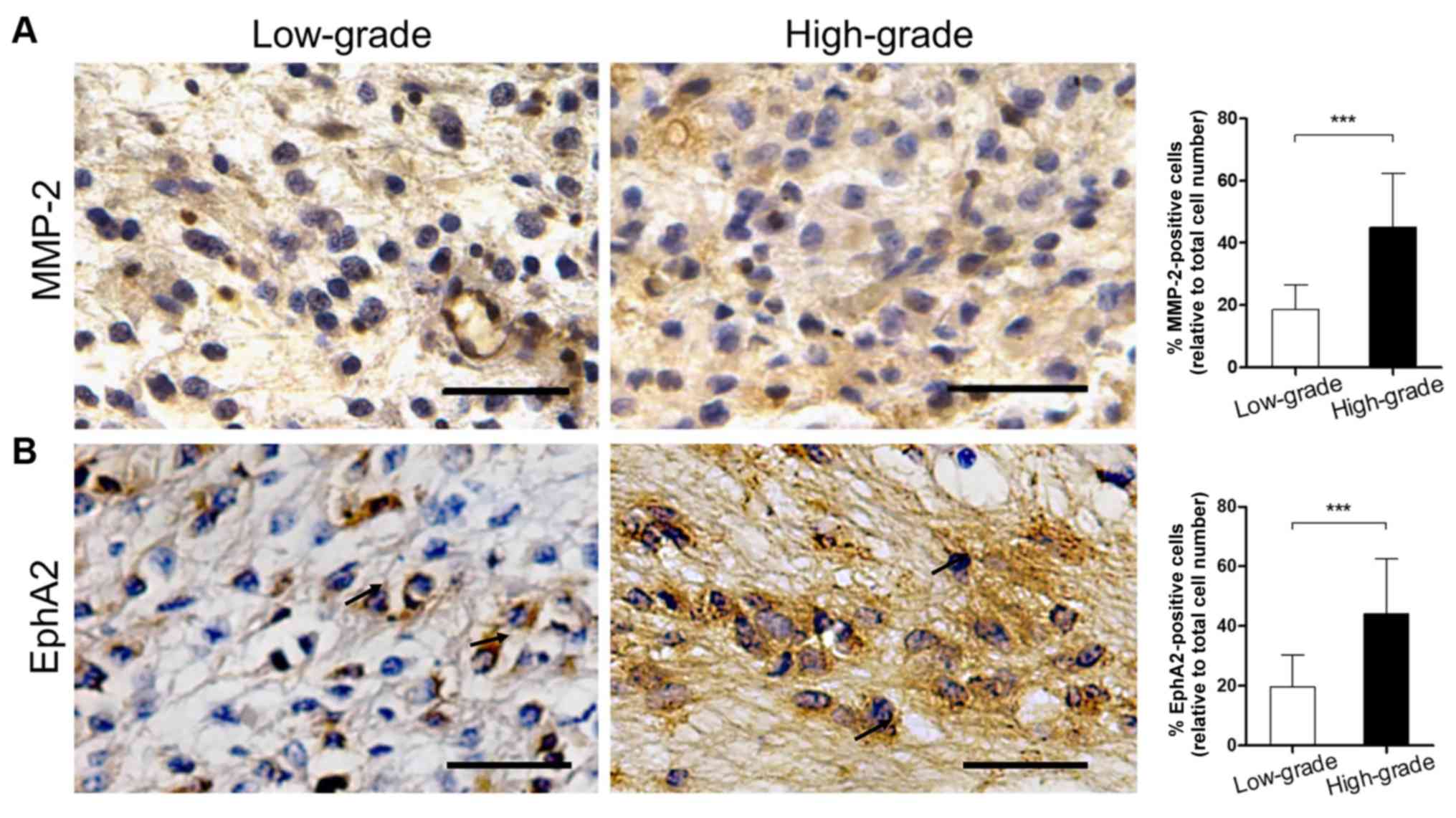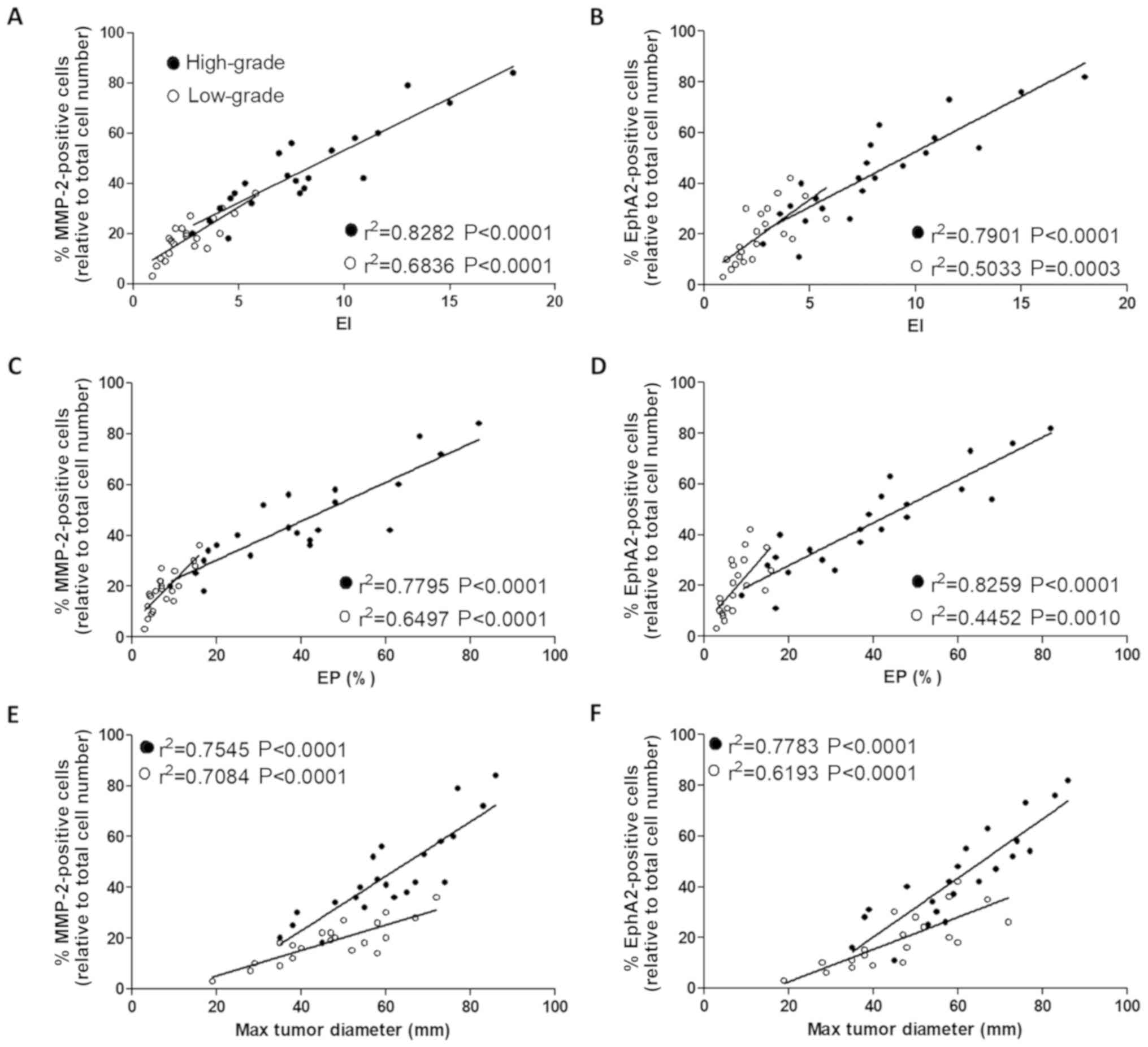|
1
|
Appin CL and Brat DJ: Molecular genetics
of gliomas. Cancer J. 20:66–72. 2014. View Article : Google Scholar : PubMed/NCBI
|
|
2
|
Goodenberger ML and Jenkins RB: Genetics
of adult glioma. Cancer Genet. 205:613–621. 2012. View Article : Google Scholar : PubMed/NCBI
|
|
3
|
Ostrom QT, Gittleman H, Farah P, Ondracek
A, Chen Y, Wolinsky Y, Stroup NE, Kruchko C and Barnholtz-Sloan JS:
CBTRUS statistical report: Primary brain and central nervous system
tumors diagnosed in the United States in 2006–2010. Neuro Oncol. 15
(Suppl 2):ii1–ii56. 2013. View Article : Google Scholar : PubMed/NCBI
|
|
4
|
Louis DN, Perry A, Reifenberger G, von
Deimling A, Figarella-Branger D, Cavenee WK, Ohgaki H, Wiestler OD,
Kleihues P and Ellison DW: The 2016 world health organization
classification of tumors of the central nervous system: A summary.
Acta Neuropathol. 131:803–820. 2016. View Article : Google Scholar : PubMed/NCBI
|
|
5
|
Wu W, Lamborn KR, Buckner JC, Novotny PJ,
Chang SM, O'Fallon JR, Jaeckle KA and Prados MD: Joint NCCTG and
NABTC prognostic factors analysis for high-grade recurrent glioma.
Neuro Oncol. 12:164–172. 2010. View Article : Google Scholar : PubMed/NCBI
|
|
6
|
Bauvois B: New facets of matrix
metalloproteinases MMP-2 and MMP-9 as cell surface transducers:
Outside-in signaling and relationship to tumor progression. Biochim
Biophys Acta. 1825:29–36. 2012.PubMed/NCBI
|
|
7
|
Yadav L, Puri N, Rastogi V, Satpute P,
Ahmad R and Kaur G: Matrix metalloproteinases and cancer-roles in
threat and therapy. Asian Pac J Cancer Prev. 15:1085–1091. 2014.
View Article : Google Scholar : PubMed/NCBI
|
|
8
|
Fingleton B: Matrix metalloproteinases:
Roles in cancer and metastasis. Front Biosci. 11:479–491. 2006.
View Article : Google Scholar : PubMed/NCBI
|
|
9
|
Martin MD and Matrisian LM: The other side
of MMPs: Protective roles in tumor progression. Cancer Metast Rev.
26:717–724. 2007. View Article : Google Scholar
|
|
10
|
Egeblad M and Werb Z: New functions for
the matrix metalloproteinases in cancer progression. Nat Rev
Cancer. 2:161–174. 2002. View
Article : Google Scholar : PubMed/NCBI
|
|
11
|
Cho HJ, Park JH, Nam JH, Chang YC, Park B
and Hoe HS: Ascochlorin Suppresses MMP-2-Mediated Migration and
Invasion by targeting FAK and JAK-STAT signaling cascades. J Cell
Biochem. 119:300–313. 2018. View Article : Google Scholar : PubMed/NCBI
|
|
12
|
Farina P, Tabouret E, Lehmann P, Barrie M,
Petrirena G, Campello C, Boucard C, Graillon T, Girard N and Chinot
O: Relationship between magnetic resonance imaging characteristics
and plasmatic levels of MMP2 and MMP9 in patients with recurrent
high-grade gliomas treated by Bevacizumab and Irinotecan. J
Neurooncol. 132:433–437. 2017. View Article : Google Scholar : PubMed/NCBI
|
|
13
|
Ou Y, Wu Q, Wu C, Liu X, Song Y and Zhan
Q: Migfilin promotes migration and invasion in glioma by driving
EGFR and MMP-2 signalings: A positive feedback loop regulation. J
Genet Genomics. 44:557–565. 2017. View Article : Google Scholar : PubMed/NCBI
|
|
14
|
van der Geer P, Hunter T and Lindberg RA:
Receptor protein-tyrosine kinases and their signal transduction
pathways. Annu Rev Cell Biol. 10:251–337. 1994. View Article : Google Scholar : PubMed/NCBI
|
|
15
|
Miao H and Wang B: Eph/ephrin signaling in
epithelial development and homeostasis. Int J Biochem Cell Biol.
41:762–770. 2009. View Article : Google Scholar : PubMed/NCBI
|
|
16
|
Kullander K and Klein R: Mechanisms and
functions of Eph and ephrin signalling. Nat Rev Mol Cell Biol.
3:475–486. 2002. View
Article : Google Scholar : PubMed/NCBI
|
|
17
|
Nakamoto M and Bergemann AD: Diverse roles
for the Eph family of receptor tyrosine kinases in carcinogenesis.
Microsc Res Tech. 59:58–67. 2002. View Article : Google Scholar : PubMed/NCBI
|
|
18
|
Pasquale EB: Eph-ephrin bidirectional
signaling in physiology and disease. Cell. 133:38–52. 2008.
View Article : Google Scholar : PubMed/NCBI
|
|
19
|
Miao H, Li DQ, Mukherjee A, Guo H, Petty
A, Cutter J, Basilion JP, Sedor J, Wu J, Danielpour D, et al: EphA2
mediates ligand-dependent inhibition and ligand-independent
promotion of cell migration and invasion via a reciprocal
regulatory loop with Akt. Cancer Cell. 16:9–20. 2009. View Article : Google Scholar : PubMed/NCBI
|
|
20
|
Ireton RC and Chen J: EphA2 receptor
tyrosine kinase as a promising target for cancer therapeutics. Curr
Cancer Drug Targets. 5:149–157. 2005. View Article : Google Scholar : PubMed/NCBI
|
|
21
|
Zeng G, Hu Z, Kinch MS, Pan CX, Flockhart
DA, Kao C, Gardner TA, Zhang S, Li L, Baldridge LA, et al:
High-level expression of EphA2 receptor tyrosine kinase in
prostatic intraepithelial neoplasia. Am J Pathol. 163:2271–2276.
2003. View Article : Google Scholar : PubMed/NCBI
|
|
22
|
Miao H, Gale NW, Guo H, Qian J, Petty A,
Kaspar J, Murphy AJ, Valenzuela DM, Yancopoulos G, Hambardzumyan D,
et al: EphA2 promotes infiltrative invasion of glioma stem cells in
vivo through cross-talk with Akt and regulates stem cell
properties. Oncogene. 34:558–567. 2015. View Article : Google Scholar : PubMed/NCBI
|
|
23
|
Cheng N, Brantley DM, Liu H, Lin Q,
Enriquez M, Gale N, Yancopoulos G, Cerretti DP, Daniel TO and Chen
J: Blockade of EphA receptor tyrosine kinase activation inhibits
vascular endothelial cell growth factor-induced angiogenesis. Mol
Cancer Res. 1:2–11. 2002. View Article : Google Scholar : PubMed/NCBI
|
|
24
|
Ogawa K, Pasqualini R, Lindberg RA, Kain
R, Freeman AL and Pasquale EB: The ephrin-A1 ligand and its
receptor, EphA2, are expressed during tumor neovascularization.
Oncogene. 19:6043–6052. 2000. View Article : Google Scholar : PubMed/NCBI
|
|
25
|
Khurshid SJ and Hussain AM: Nuclear
magnetic resonance imaging (MRI). J Pak Med Assoc. 41:259–264.
1991.PubMed/NCBI
|
|
26
|
Cavezian R, Cabanis EA, Pasquet G,
Iba-Zizen MT, Le Bihan D, Tamraz J and Roger B: Magnetic resonance
imaging. Physical principles, current biomedical applications,
maxillofacial perspectives. Actual Odontostomatol (Paris).
40:219–232. 1986.(In French). PubMed/NCBI
|
|
27
|
Guy RL, Benn JJ, Ayers AB, Bingham JB,
Lowy C, Cox TC and Sonksen PH: A comparison of CT and MRI in the
assessment of the pituitary and parasellar region. Clin Radiol.
43:156–161. 1991. View Article : Google Scholar : PubMed/NCBI
|
|
28
|
Qi S, Yu L, Li H, Ou Y, Qiu X, Ding Y, Han
H and Zhang X: Isocitrate dehydrogenase mutation is associated with
tumor location and magnetic resonance imaging characteristics in
astrocytic neoplasms. Oncol Lett. 7:1895–1902. 2014. View Article : Google Scholar : PubMed/NCBI
|
|
29
|
Puttick S, Bell C, Dowson N, Rose S and
Fay M: PET, MRI, and simultaneous PET/MRI in the development of
diagnostic and therapeutic strategies for glioma. Drug Discov
Today. 20:306–317. 2015. View Article : Google Scholar : PubMed/NCBI
|
|
30
|
Crooks V, Waller S, Smith T and Hahn TJ:
The use of the karnofsky performance scale in determining outcomes
and risk in geriatric outpatients. J Gerontol. 46:M139–M144. 1991.
View Article : Google Scholar : PubMed/NCBI
|
|
31
|
de Haan R, Aaronson N, Limburg M, Hewer RL
and Van Crevel H: Measuring quality of life in stroke. Stroke.
24:320–327. 1993. View Article : Google Scholar : PubMed/NCBI
|
|
32
|
Okada A: Roles of matrix
metalloproteinases and tissue inhibitor of metalloproteinase (TIMP)
in cancer invasion and metastasis. Gan To Kagaku Ryoho.
26:2247–2252. 1999.(In Japanese). PubMed/NCBI
|
|
33
|
Itoh T, Tanioka M, Yoshida H, Yoshioka T,
Nishimoto H and Itohara S: Reduced angiogenesis and tumor
progression in gelatinase A-deficient mice. Cancer Res.
58:1048–1051. 1998.PubMed/NCBI
|
|
34
|
Rao JS: Molecular mechanisms of glioma
invasiveness: The role of proteases. Nat Rev Cancer. 3:489–501.
2003. View
Article : Google Scholar : PubMed/NCBI
|
|
35
|
Yue X, Lan F, Yang W, Yang Y, Han L, Zhang
A, Liu J, Zeng H, Jiang T, Pu P and Kang C: Interruption of
β-catenin suppresses the EGFR pathway by blocking multiple
oncogenic targets in human glioma cells. Brain Res. 1366:27–37.
2010. View Article : Google Scholar : PubMed/NCBI
|
|
36
|
Chicoine MR and Silbergeld DL: The in
vitro motility of human gliomas increases with increasing grade of
malignancy. Cancer. 75:2904–2909. 1995. View Article : Google Scholar : PubMed/NCBI
|
|
37
|
Wykosky J, Gibo DM, Stanton C and Debinski
W: EphA2 as a novel molecular marker and target in glioblastoma
multiforme. Mol Cancer Res. 3:541–551. 2005. View Article : Google Scholar : PubMed/NCBI
|
|
38
|
Langer A: A systematic review of PET and
PET/CT in oncology: A way to personalize cancer treatment in a
cost-effective manner? BMC Health Serv Res. 10:2832010. View Article : Google Scholar : PubMed/NCBI
|
|
39
|
Ross R: Advances in the application of
imaging methods in applied and clinical physiology. Acta Diabetol.
40 (Suppl 1):S45–S50. 2003. View Article : Google Scholar : PubMed/NCBI
|
|
40
|
Caravan P, Ellison JJ, McMurry TJ and
Lauffer RB: Gadolinium(III) chelates as MRI contrast agents:
Structure, dynamics, and applications. Chem Rev. 99:2293–2352.
1999. View Article : Google Scholar : PubMed/NCBI
|
|
41
|
Zhou Z and Lu ZR: Gadolinium-based
contrast agents for magnetic resonance cancer imaging. Wiley
Interdiscip Rev Nanomed Nanobiotechnol. 5:1–18. 2013. View Article : Google Scholar : PubMed/NCBI
|
|
42
|
Ye F, Liu J and Ouyang H: Gadolinium
ethoxybenzyl diethylenetriamine pentaacetic acid
(Gd-EOB-DTPA)-enhanced magnetic resonance imaging and
multidetector-row computed tomography for the diagnosis of
hepatocellular carcinoma: A systematic review and meta-analysis.
Medicine (Baltimore). 94:e11572015. View Article : Google Scholar : PubMed/NCBI
|
|
43
|
Ying SH, Teng XD, Wang ZM, Wang QD, Zhao
YL, Chen F and Xiao WB: Gd-EOB-DTPA-enhanced magnetic resonance
imaging for bile duct intraductal papillary mucinous neoplasms.
World J Gastroenterol. 21:7824–7833. 2015. View Article : Google Scholar : PubMed/NCBI
|
|
44
|
Chung C, Metser U and Menard C: Advances
in magnetic resonance imaging and positron emission tomography
imaging for grading and molecular characterization of glioma. Semin
Radiat Oncol. 25:164–171. 2015. View Article : Google Scholar : PubMed/NCBI
|
|
45
|
Zuo N, Cheng J and Jiang T: Diffusion
magnetic resonance imaging for Brainnetome: A critical review.
Neurosci Bull. 28:375–388. 2012. View Article : Google Scholar : PubMed/NCBI
|
|
46
|
Jahng GH, Li KL, Ostergaard L and
Calamante F: Perfusion magnetic resonance imaging: A comprehensive
update on principles and techniques. Korean J Radiol. 15:554–577.
2014. View Article : Google Scholar : PubMed/NCBI
|
|
47
|
Ledezma CJ, Chen W, Sai V, Freitas B,
Cloughesy T, Czernin J and Pope W: 18F-FDOPA PET/MRI fusion in
patients with primary/recurrent gliomas: Initial experience. Eur J
Radiol. 71:242–248. 2009. View Article : Google Scholar : PubMed/NCBI
|
|
48
|
Chen W and Silverman DH: Advances in
evaluation of primary brain tumors. Semin Nucl Med. 38:240–250.
2008. View Article : Google Scholar : PubMed/NCBI
|
|
49
|
Costello JF: DNA methylation in brain
development and gliomagenesis. Front Biosci. 8 (Suppl):S175–S184.
2003. View Article : Google Scholar : PubMed/NCBI
|
|
50
|
Carlson MR, Pope WB, Horvath S, Braunstein
JG, Nghiemphu P, Tso CL, Mellinghoff I, Lai A, Liau LM, Mischel PS,
et al: Relationship between survival and edema in malignant
gliomas: Role of vascular endothelial growth factor and neuronal
pentraxin 2. Clin Cancer Res. 13:2592–2598. 2007. View Article : Google Scholar : PubMed/NCBI
|
|
51
|
Pope WB, Sayre J, Perlina A, Villablanca
JP, Mischel PS and Cloughesy TF: MR imaging correlates of survival
in patients with high-grade gliomas. AJNR Am J Neuroradiol.
26:2466–2474. 2005.PubMed/NCBI
|

















